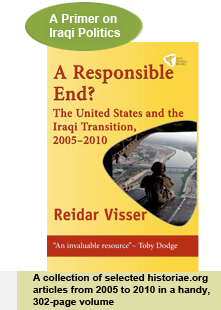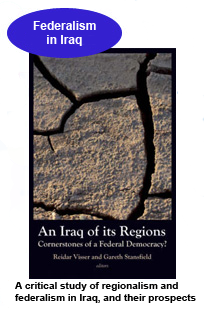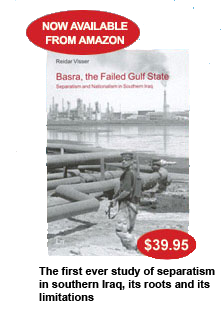



| Main | |
| Documents & images | |
| Links | |
| Contact | |
 | |
| amazon.com |

|
|
|
amazon.com
amazon.co.uk |
|

|
|
|
amazon.com
amazon.co.uk |
|
Partial Election Results for 13 Governorates Released by IHEC
By Reidar Visser (www.historiae.org)
14 March 2010
After a good deal of dithering, including the release of erroneous numbers and a subsequent withdrawal, IHEC has now made available partial results for 13 governorates. This material has the advantage in that it is complete and not limited to the numbers of the front-runners only, thereby enabling an evaluation of changes in percentages since the local elections last year, as well as analyses of intra-list trends. For Basra and Anbar, released today in the evening, the material is quite substantial as well, with more than 50% of the votes counted.
Governorate (percentage counted) |
SLA% 2010 |
SLA% 2009 |
INA% 2010 |
INA% 2009 |
INM% 2010 |
INM% 2009 |
Basra (63) |
53 |
37 |
29 |
29 |
9 |
3 |
Maysan (23) |
38 |
18 |
50 |
39 |
5 |
2 |
Muthanna (18) |
41 |
11 |
30 |
20 |
8 |
4 |
Babel (34) |
39 |
13 |
31 |
19 |
18 |
3 |
Qadisiyya (10) |
28 |
23 |
40 |
34 |
12 |
8 |
Najaf (34) |
45 |
16 |
39 |
34 |
2 |
2 |
Baghdad (18) |
39 |
38 |
27 |
20 |
26 |
9 |
Diyala (17) |
13 |
6 |
13 |
10 |
53 |
10 |
Salahaddin (18) |
9 |
4 |
6 |
5 |
44 |
14 |
Nineveh (15) |
2 |
- |
3 |
- |
58 |
53 |
Anbar (59) |
1 |
- |
1 |
- |
61 |
25 |
| Karbala (35) | 53 | 9 | 24 | 20 | 11 | 2 |
| Wasit (63) | 40 | 15 | 35 | 21 | 14 | 5 |
| Dhi Qar (59) | 38 | 23 | 40 | 39 | 7 | 3 |
| Kirkuk (52) | 2 | n/a | 2 | n/a | 38 | n/a |
SLA=State of Law Alliance
INA=Iraqi National Alliance
INM=Iraqi National Movement/Iraqiyya
Updated on 15 March with figures for all governorates south of Kurdistan, as released by IHEC. New percentages have been calculated on basis of the IHEC statistiscs which give a fuller picture than the partial data for selected entities that have been circulated by media.
The first tendency that becomes evident by looking at percentages and comparing them over time (which is possible by computing the percentages achieved in 2009 by the constituent elements of today’s alliances) is that the crude analysis of INA as the great loser south of Baghdad is only partially correct. In fact, just like Maliki, INA, has made progress in several areas compared to January 2009 (and apperas to be doing better than Maliki in places like Maysan and Qadisiyya, although the latter result is based only on very small numbers so far). In that way, it seems that a change in voter behaviour may be equally important, namely, that the proportion of wasted votes for very small lists is now getting smaller, and that three main entities emerge south of Kurdistan.
The other key trend is that Maliki is doing fantastically well in Baghdad and most places south of it, but is performing dismally to the north of the Iraqi capital. Conversely, Iraqiyya has made enormous gains north of Baghdad, perhaps to the point that one might speak of a Sunnification of the party. This is however only partially true: Iraqiyya is also making progress south of Baghdad, albeit on a more modest scale. And while a second term for Maliki would mean a premier with 1-2 percent support in key areas like Anbar and Mosul based on this material, Allawi at least has managed to hold on to a decent 10% even in his weakest areas (except Maysan, with 5% so far) – an impressive achievement also given that the coalition does not really have much of a party machinery to speak of, and also cannot rely on militias or control of the state apparatus. Also, it is reported late Sunday that Iraqiyya is in the lead in Kirkuk, even ahead of the Kurds, which would be a surprise outcome if it continues that way (may have to do with enclave-like local geography, although the same news agency misreported a supposed State of Law lead in Salahaddin earlier in the week). At any rate, it seems clear that Allawi has won the nationalist vote in multi-ethnic Kirkuk at the expense of both Maliki and INA.
The inevitable general conclusion remains that State of Law is too weak north of Baghdad and Iraqiyya a bit too weak south of it. In other words, to some extent INA’s de-Baathification succeeded: It boxed in Maliki and prevented him from winning much-needed allies in the north (of course, Maliki himself and messages from Washington telling him to avoid any kind of friction with the Kurds also played significant roles in bringing about this outcome), and at the same time may have intimidated potential Allawi voters in the Shiite-majority areas who for the past weeks have seen the idea of the rule of law collapse as impromptu de-Baathification has taken place in their local communities. But while INA may have had an influence in terms of creating a sectarian pattern in voting behaviour, it apparently did not work primarily to its own advantage but rather towards solidifying State of Law as a mainly Shiite-oriented Iraqi nationalist coalition and Iraqiyya as a somewhat more Sunni-oriented one.
Indications are therefore that south of Kurdistan, everything is going to be mostly about these three alliances. By contrast Tawafuq, as expected, has been decimated everywhere including in former strongholds like Salahaddin and Diyala, and Unity of Iraq is clearly behind Iraqiyya in most places. Alliances like these could however become of importance in the coalition-forming process.
Also directly related to the coalition-forming process is the impact of the open-list system and its consequences for internal alliance stability. Already a pattern whereby Sadrists make advances within INA and thereby threaten to upset the internal balance of that alliance has become discernable in the early results. This tendency is only strengthened in the newly released material, not least with respect to Baghdad where number three candidate Ahmad Chalabi has suffered the misfortune of being outperformed by no less than seven Sadrists in Baghdad, some from places as far down on the list as 83! Sadrist thus account for seven of the top nine INA candidates in Baghdad so far, with only Ibrahim al-Jaafari and Bayan Solagh holding on to their original positions. But whereas both these men have been mentioned as possible prime ministerial candidates for INA, they are dwarfed by comparison with Nuri al-Maliki and Ayad Allawi, who clearly stand out with the biggest numbers of personal votes so far. Also, in State of Law and Iraqiyya there is a tendency towards less interference with the ranking of candidates (i.e. through voters actively promoting other favourites than the top candidates), although not everywhere (Basra appears to be an exception).
In sum, it seems clear that the open-list system will hit INA particularly hard, with pronounced tension between Sadrists and the old elites, who chose not to run or ran as symbolic candidates in non-winning constituencies in Kurdistan, but who still dominate the ongoing attempts at exploring alliances with a view to possible government formation. Who is negotiating with the winning Sadrists?
This article will be updated as new numbers emerge (more figures are promised in the coming week). Significant new trends will be reported at Iraq and Gulf Analysis. A new article will be published when final (uncertified) results are available, probably towards the end of March.
To comment on this article, click here.
Copyright © 2005-2010 historiae.org & Reidar Visser
This document or quotes from it may be freely reproduced as long as www.historiae.org is credited as the original source.
